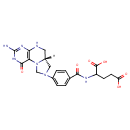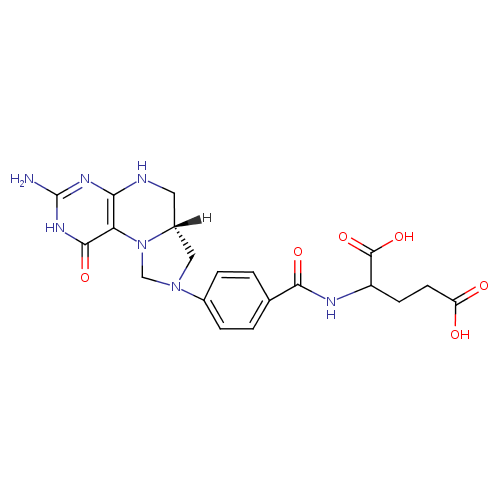|
Record Information |
|---|
| Version |
1.0 |
|---|
| Update Date |
1/22/2018 11:54:54 AM |
|---|
|
Metabolite ID | PAMDB110839 |
|---|
|
Identification |
|---|
| Name: |
5,10-methylenetetrahydropteroyl mono-L-glutamate |
|---|
| Description: | 5,10-Methylene-THF is an intermediate in glycine, serine and threonine metabolism and one carbon metabolism. 5,10-CH2-THF can also be used as a coenzyme in the biosynthesis of thymidine. More specifically it is the C1-donor in the reactions catalyzed by thymidylate synthase and thymidylate synthase (FAD). It also acts as a coenzyme in the synthesis of serine from glycine via the enzyme serine hydroxymethyl transferase. 5,10-Methylene-THF is a substrate for Methylenetetrahydrofolate reductase. This enzyme converts 5,10-methylenetetrahydrofolate to 5-methyltetrahydrofolate. This reaction is required for the multistep process that converts the amino acid homocysteine to methionine. The body uses methionine to make proteins and other important compounds. 5,10-CH2-THF is a substrate for many enzymes including Bifunctional methylenetetrahydrofolate dehydrogenase/cyclohydrolase (mitochondrial), Aminomethyltransferase (mitochondrial), Serine hydroxymethyltransferase (mitochondrial), Methylenetetrahydrofolate reductase, C-1-tetrahydrofolate synthase (cytoplasmic), Serine hydroxymethyltransferase (cytosolic) and Thymidylate synthase. |
|---|
|
Structure |
|
|---|
| Synonyms: | -
N5,N10-methylenetetrahydrofolate mono-L-glutamate
-
5,10-methylenetetrahydrofolate mono-L-glutamate
-
5,10-methylene-H4PteGlu1
|
|---|
|
Chemical Formula: |
C20H21N7O6
|
|---|
| Average Molecular Weight: |
455.43 |
|---|
| Monoisotopic Molecular
Weight: |
457.1709815073 |
|---|
| InChI Key: |
QYNUQALWYRSVHF-OLZOCXBDSA-L |
|---|
| InChI: |
InChI=1S/C20H23N7O6/c21-20-24-16-15(18(31)25-20)27-9-26(8-12(27)7-22-16)11-3-1-10(2-4-11)17(30)23-13(19(32)33)5-6-14(28)29/h1-4,12-13H,5-9H2,(H,23,30)(H,28,29)(H,32,33)(H4,21,22,24,25,31)/p-2/t12-,13+/m1/s1 |
|---|
| CAS
number: |
31690-11-6 |
|---|
| IUPAC Name: | N- {4- {4- [(6aR)- [(6aR)- 3- 3- amino- amino- 1- 1- oxo- oxo- 1,2,5,6,6a,7- 1,2,5,6,6a,7- hexahydroimidazo[1,5- hexahydroimidazo[1,5- f]pteridin- f]pteridin- 8(9H)- 8(9H)- yl]benzoyl}- yl]benzoyl}- L- L- glutamate glutamate |
|---|
|
Traditional IUPAC Name: |
2-({4-[(6aR)-3-amino-1-oxo-2H,5H,6H,6aH,7H,9H-imidazolidino[1,5-f]pteridin-8-yl]phenyl}formamido)pentanedioic acid |
|---|
| SMILES: | C4(NC1(N=C(N)NC(=O)C=1N3(CN(C2(=CC=C(C=C2)C(=O)NC(CCC([O-])=O)C([O-])=O))C[CH]34))) |
|---|
|
Chemical Taxonomy |
|---|
|
Taxonomy Description | This compound belongs to the class of chemical entities known as tetrahydrofolic acids. These are heterocyclic compounds based on the 5,6,7,8-tetrahydropteroic acid skeleton conjugated with at least one L-glutamic acid unit. |
|---|
|
Kingdom |
Chemical entities |
|---|
| Super Class | Organic compounds |
|---|
|
Class |
Organoheterocyclic compounds |
|---|
| Sub Class | Pteridines and derivatives |
|---|
|
Direct Parent |
Tetrahydrofolic acids |
|---|
| Alternative Parents |
|
|---|
| Substituents |
- Tetrahydrofolic acid
- Glutamic acid or derivatives
- N-acyl-alpha amino acid or derivatives
- N-acyl-alpha-amino acid
- Hippuric acid or derivatives
- Hippuric acid
- Phenylimidazolidine
- Alpha-amino acid or derivatives
- Benzamide
- Benzoic acid or derivatives
- Imidazopyrazine
- Benzoyl
- Aniline or substituted anilines
- Dialkylarylamine
- Aminopyrimidine
- Secondary aliphatic/aromatic amine
- Pyrimidone
- Dicarboxylic acid or derivatives
- Pyrimidine
- Monocyclic benzene moiety
- Benzenoid
- Primary aromatic amine
- Heteroaromatic compound
- Vinylogous amide
- Imidazolidine
- Secondary carboxylic acid amide
- Amino acid or derivatives
- Amino acid
- Carboxamide group
- Azacycle
- Carboxylic acid
- Carboxylic acid derivative
- Organooxygen compound
- Organic nitrogen compound
- Carbonyl group
- Hydrocarbon derivative
- Amine
- Organic oxide
- Organopnictogen compound
- Organic oxygen compound
- Primary amine
- Organonitrogen compound
- Aromatic heteropolycyclic compound
|
|---|
| Molecular Framework |
Aromatic heteropolycyclic compounds |
|---|
| External Descriptors |
Not Available |
|---|
|
Physical Properties |
|---|
| State: |
Solid |
|---|
| Charge: | -2 |
|---|
|
Melting point: |
Not Available |
|---|
| Experimental Properties: |
| Property | Value | Reference |
|---|
| Melting Point | Not Available | Not Available | | Boiling Point | Not Available | Not Available | | Water Solubility | Not Available | Not Available | | LogP | Not Available | Not Available |
|
|---|
| Predicted Properties |
|
|---|
|
Biological Properties |
|---|
| Cellular Locations: |
Not Available |
|---|
| Reactions: | |
|---|
|
Pathways: |
|
|---|
|
Spectra |
|---|
| Spectra: |
|
|---|
|
References |
|---|
| References: |
Not Available |
|---|
| Synthesis Reference: |
Agrawal, Nitish; Mihai, Cornelia; Kohen, Amnon. Microscale synthesis of isotopically labeled R-[6-xH]N5,N10-methylene-5,6,7,8-tetrahydrofolate as a cofactor for thymidylate synthase. Analytical Biochemistry (2004), 328(1), 44-50. |
|---|
| Material Safety Data Sheet (MSDS) |
Not Available |
|---|
|
Links |
|---|
| External Links: |
|
|---|


